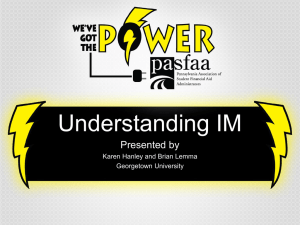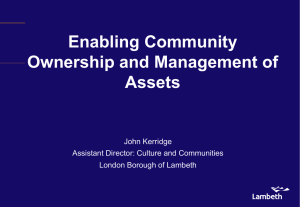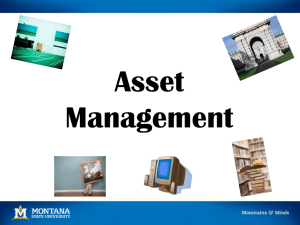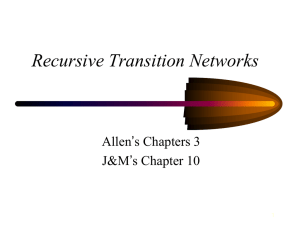Cost - Finance & Business Services
advertisement
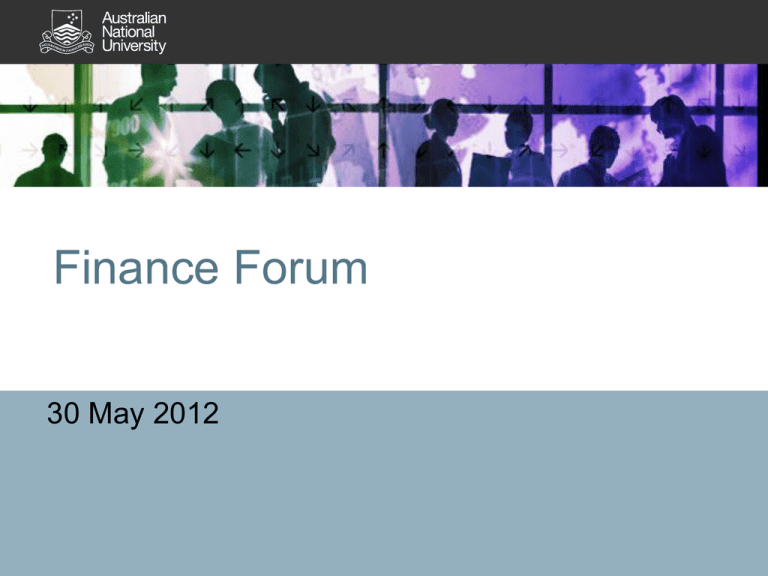
Finance Forum 30 May 2012 Welcome & Overview • David Sturgiss Finance and Business Services Overview • • • • • • • • • • • Welcome and Overview David Sturgiss OCR and Proposed AP Workflow Jaya Ganasan University Banking Arrangements Post NAB Jaya Ganasan Finance System Upgrade Update Eric Li & Leo Lai Life After Finance & Business Services Melissa Orr Afternoon tea Assets Cost Reconciliation Lee Jnani Recap of ARC Reporting Lorraine Piper Changes to Living Away From Home Allowances Luke Beckett Project Updates Vanessa Quigley Risk Management & Audit Office Yoon-Jin Park OCR and Proposed AP Workflow • Jaya Ganasan Reason For Upgrade • University currently running on V8.8. Oracle Extended support for PeopleSoft Solutions 8.8 ended in Dec 2011. • This means that Oracle is not obliged to provide development support in the form of new features and fixes including tax and regulatory updates to customers running 8.8 after that time. • University is also unable to benefit from the many enhancements incorporated in the latest release – version 9.1 5 Project Status • Upgrade project commenced in April 2011. • Upgrade process involves both technical and functional staff performing a number of “tests – fixes – retests” cycles to ensure that the system and financial processes are performing as they should on the new version. • Critical (risk mitigation) decision was made to upgrade current processes without change, and implement new functionality as follow-on projects. • Scheduled for Completion and Go Live in July 2012 as originally planned. 6 Follow On/Concurrent Project - Review all financial business processes Objective - - to streamline and remove duplicative and redundant activities reduction / elimination of paper based forms. standardization of financial business processes across the University. migration of paper based processes (eg travel approvals) to on line systems. achieve administrative efficiencies through standardization and automation. 7 Specific Improvement Opportunities • Accounts Payable Invoice to Pay Automation • Accounts Receivable and Miscellaneous Revenue Collection • Procurement Processes • Travel Request and Approval Process and Travel Related Expense Management • Corporate Card Expenses Policy Compliance and Acquittal Process Improvements • Elimination of earlier modifications by adopting new functionality 8 Accounts Payable Invoice to Pay Automation – Sept 2012 Use of Optical Character Recognition Scanning and Peoplesoft Workflow will achieve the following outcomes: - Reduction/elimination of data entry of Invoice information - Email approval of scanned invoices - Digital storage of invoice records (elimination of paper storage) - Improved turnaround times from receipt to payment of invoices - Complete transparency of AP work process flow 9 Accounts Receivable and Miscellaneous Revenue Collection – Dec 2012 Upgrade to One Stop Cash Receipting system and new functionality in Peoplesoft will provide: - opportunities to reduce cash collection points throughout campus through introduction of web based options. - on line approval of invoices and credit notes - conversion of paper forms to electronic versions enabling on-line approvals. 10 Procurement Processes Initiatives – Sept to June 2013 • Integration of Chemical Inventory System with Peoplesoft Procurement Module to eliminate duplicate processes. • Explore E- catalogue solution to enable fast search by product and “side-by-side” product comparison to drive best value purchasing. • Mandatory requirement to raise Purchase Orders for procurement exceeding $5,000 to: – Simplify invoice processing – Improve financial reporting and budget management – Ensure compliance with procurement due diligence requirements 11 Travel Request and Approval Process and Travel Related Expense Management – March 2013 • Integrated on line system for Travel Requests and Approval. • Capture of all Travel Related expenses by Travel Event. • Automatic general ledger account coding (based on expense category). 12 Corporate Card Expenses Policy Compliance and Acquittal Process Improvements – March 2013 • On line system for Corporate Card Expenditure Approval. • Automatic general ledger account coding (based on expense category). • Email alerts and automatic escalation for unresolved transactions. • On-line forms and system controls to eliminate manual forms and assist in tax compliance. 13 Elimination of earlier modifications by adopting new functionality The following modifications will be redundant with the adoption of new functionality in Peoplesoft Financials -Corporate Card acquittal “bolt-on” and related AP/HR integration. -Accounts Payable Voucher approval modifications. (New on-line approval workflow defined). 14 Joint approach with Colleges to improve systems • We need University wide systems • The Peoplesoft system will drive the automation & workflow • Sometimes a College will need extra steps in a process (but rarely) • College Finance Staff/ Managers/Academics to be part of the team determining the best way forward 15 QUESTIONS ? 16 University Banking Arrangements Post NAB • Jaya Ganasan Finance System Upgrade Update • Eric Li & Leo Lai From Now to Go live Move to Production – Post User Testing Performance Testing Go live Move to Production – Trial Go Live 19 Feedbacks from End User Testing • Changes on background colour & navigation • Tips & technique documentation required for specific system changes • No special training is required 20 Major System Differences • AP – Payment Comments 21 Major System Differences • Inventory – Changes on MSR 22 Encumbrances Conversion • Encumbrance balances will start from scratch – – – – No impacts on historical balances/reports All open Reqs and POs will be set to ‘Complete’ Open POs over $10,000 will be re-entered centrally All unapproved encumbrance Jrnls will be deleted 23 General Information • All personal favourites will be migrated into v9.1 • Run Control IDs are required to be setup • The log in to ES Financials will be redirected to new page 24 Conversion Strategy • AP – all Vchrs must be approved and Match Exceptions must be overridden • PCard Vchrs – must be approved • AM – Add/Update access will be removed after Accounting Period 7 (8th July), no asset transactions should be added or modified • All Reqs must be built into POs otherwise cancelled • IV – all MSRs, Picking Plans and Counting Events must be completed otherwise cancelled • AR – all Invoices must be approved otherwise cancelled – all Cancelled Invoices will not be converted • GL - all Journals must be approved otherwise deleted 25 Draft Go-Live Timetable 17th July (Tuesday) All ‘Add’ access will be removed 19th July (Thursday) All system access will be removed All unapproved Bills, Vouchers and Journals will be deleted For any unapproved PCard vouchers, the charges will go to “5890 R Areas ‘510’ Dept or Cardholders Dept” 23rd July (Monday) Restricted access may be given to F&BS 24th July (Tuesday) System is opened to all finance areas 26 Planned Post Implementation Training • Information session • Drop-in session will be run twice a day • Normal help-desk support 27 • THE END 28 Cost Reconciliation of Capitalised Assets • Lee Jnani Outline • • • • • • Asset definition Asset classes Asset capitalisation procedure Asset life cycle Accounting system Cost reconciliation business process 30 Accounting Definition of Asset AASB 116: “Recognise the cost of an item or property, plant, equipment as an asset if, and only if: • It is probable that future economic benefits associated with the item, beyond the year of purchase, will flow to the entity; and • The cost of the item can be measured reliably.” 31 Asset Classes Cash & Cash Equivalents Land, Building, Infrastructure Plant, Property & Equipment Intangibles Financial Assets Non Financial Assets 32 PPE Asset Categories Computer Equipment Research Equipment Teaching Equipment Motor Vehicles Musical Equipment Other Equipment PPE Assets Artworks 33 Asset Recognition Threshold Capitalised Asset Unit Price (GST exclusive) >/= $5,000 NonCapitalised Asset Unit Price (GST exclusive) <$5,000 Capitalised as PPE in Balance Sheet Expensed in Income Statement Account 31xx Account 51xx Recorded in Asset Management System Recorded in Portable & Attractive Register 34 Life Cycle of A Capitalised Asset Acquisition • Purchasing • Capitalisation Retirement Management • Asset Disposal • • • • Depreciation Asset Transfer Cost adjustment Re-classification 35 Life Cycle of a Non-Capitalised Asset Acquisition - Expensed Retirement Management 36 ESP Financials and Subsidiary Ledgers Accounts Payable General Ledger Asset Management System Accounts Receivable 37 How to Record Financial Events on Capitalised Assets? – PeopleSoft (ESP FIN) General Ledger (GL) Asset Management System (AMS) 38 Purpose of Cost Reconciliation on Capitalised Assets • For Any Asset Class • For Any Charging Code Higher Risk GL AMS Accumulated Depreciation Accumulated Depreciation Cost Cost 39 P5 Asset Cost Reconciliation Shows… GL AMS Variance $293.5 mill $288.7 mill $4.8 mill 40 Consequences of the Imbalance GL AMS 41 How to Clear the Imbalance? Summary by Budget Unit • Asset Class 1 – Variance 1 • Asset Class 2 – Variance 2 • Asset Class 3 – Variance 3 Detailed Analysis by Asset Class • Charging Code A – Variance A • Charging Code B – Variance B • Charging Code C – Variance C Task Table • Recommended Actions 42 ESP Version 9… • Training programs • Feedback welcome • Acknowledgement 43 Finance Forum Afternoon Tea Break Life After Finance & Business Services • Melissa Orr Journey from the dark side…… The story of one person’s life after F&BS into the “real world” F&BS positives • Mentoring from CA/CPAs • Exposure to University wide financial transactions/processes – Assets, SPF • Understanding of importance of F&BS deadlines and tasks – FBT, AFS 47 College benefits • Working with other areas – HR, students, research office • You are the finance expert – your Dean/GM rely on your advice • Working with academics (a benefit?) but makes life interesting 48 The future • For career advancement, consider all finance positions – at F&BS, Colleges, service divisions • Get away from an “us and them” mentality • Projects for finance professionals to work together 49 Recap of ARC Reporting • Lorraine Piper 2011 ARC End-of-Year Reports • Carry forward codes on Yes/No forms • Written carry forward requests are an ARC requirement • ARC EOY 2011 Report 51 2011 ARC End-of-Year Reports • Maternity leave/reimbursement from LSL pool for Fellowship holders – LSL pool automatic 20 weeks @80% of salary only – ARC claim 14 weeks @ ARC funded salary + 28% oncosts – Difference between 14 weeks ARC & 14 weeks LSL pool funded amount will be calculated manually and returned to LSL pool by journal (SPF team) 52 2011 ARC End-of-Year Reports • Salary Shortfall Calculations – Issues with charging of superannuation on salary gap for Laureates to original R code base pay source – Accruals on split funding – Manual journals required through the year or at end of year – On-line balance enquiry may be unreliable for available funds determination 53 2011 ARC End-of-Year Reports • Deadlines – ARC EOY reports are due to be submitted by 31 March each year – not changed in the recent past – Plan ahead: Written requests for carry forward can be prepared in December before CIs take leave – Central Research Office reviews before sending to ARC – they need time as well 54 2011 ARC End-of-Year Reports • Ineligible Expenditure – Clean reports enable deadlines to be met – Download a transaction listing using the ARC Fund Attributes during Nov/Dec and journal out obvious ineligible expenditure • Relocation Costs – Maternity leave & relocation costs are no longer reported on the End-of-Year reports. Claims must be submitted through the year to the ARC through your Research Admin teams – Time limit on when relocation costs can be claimed – action claim quickly once reimbursement is paid to the academic 55 2011 ARC End-of-Year Reports • Transfers/Relinquishments during January/February – Calculation of figures cannot be done until after effective date of transfer/relinquishment – Encourage your Research Admin teams to notify SPF early where possible: prior to preparation of 31 December statement so that any adjustments can be incorporated into both statements 56 QUESTIONS ? 57 Living Away From Home Allowance • Luke Beckett Living Away From Home Allowance • Rules regarding living away from home allowances are changing. • Government announced initial change in The Mid-Year Economic and Fiscal Outlook (MYEFO). • More details in the 2012/2013 Commonwealth Budget. • Draft Legislation was released on 15 May 2012. • Effect of changes is to limit tax exemption from 1 July 2012. Living Away From Home Allowance Existing Arrangements 1. Non-Residents No longer tax free from 1 July 2012 60 Living Away From Home Allowance Existing Arrangements 2. Residents • Existing Arrangements will remain unaffected from 1 July 2012 and will cease at latest 1 July 2014. • Any changes to the arrangements (employment or LAFHA) will mean new rules apply. 61 Living Away From Home Allowance • Changes – Allowances paid to employees will be taxed as ordinary income – Deduction for accommodation and food will be allowed against allowance – Employees need to substantiate expenses – Food amounts will need to be greater than $110 – Food amount below a limit (unknown) won’t need to be substiated. 62 Living Away From Home Allowance • New LAFHA rules from 8 May 2012 – Applies to both residents and non-residents – Must maintain 2 houses in Australia – Maximum LAFHA deduction period of 12 months at one site – Taxable allowance will be subject to on-costs (super, workers comp & payroll tax) for ANU 63 Living Away From Home Allowance • Not Changing – Where the employer pays the expenses directly or reimburses on a receipt, the amount will remain a fringe benefit – Requirements for an exempt benefit will be in line with new allowance rules 64 Questions Contact: Luke Beckett X58739 taxunit@anu.edu.au 65 Project Updates • Vanessa Quigley Project Updates Uniforum Benchmarking Collaborative forum for Universities to benchmark their support services cost and resourcing and understand the drivers of difference ANU is participating with Uni Adelaide, Flinders Uni, Victoria Uni Wellington and Uni of Otego with the Uni of Auckland sharing their data with us. Data is from 1 January 2011 – 31 December 2011 Project Updates Uniforum Benchmarking – Staff Activity survey • To be completed by Wed 5 June 2012 – Contractors analysis • For completion by Fri 7 June 2012 – Scaling factors • Completed Project Updates Accounts structure A review of all accounts to better define how we capture information to facilitate better reporting. Includes • Ledger codes (R, Q, S, T) • School/Centre codes • project codes • business activities (teaching, research, admin) • natural accounts Project Updates Accounts structure • Developing a framework with defined rules for allocating account codes • To be used to allow for both internal and external reporting requirements • Looking at unique, consecutive codes for projects and centres, schools with a hierarchy governed by mapped trees rather than trying to use common linking numbers as done now. • Trying to capture activities such as research and teaching without having additional centres or natural accounts to capture the information • Must interact with feeder systems and be consistent with other areas of the University such as HR, stats and students • Subject to greater discussion and will not happen overnight….but it will happen Project Updates Reporting • Enhanced reporting using TM1/Cognos including traffic light reporting • Suite of standard reports with consistent data at the high and low level • Adding to the work already done in iMIS • Integrated reports, students, staff, finances • More meaningful period reporting including using ARIES data and recording out year encumbrances Project Updates Grant Budget Template • To try to create a University wide tool to complete grant budgets • Modifications for specific funds providers integrated into the one tool • Advice on overheads being sought which will be integrated • If you have tools in use I’m more than happy to steal your good ideas! Risk Management & Audit Office Reviews • Yoon-Jin Park • Internal Audit of Grant Management Framework Preparation and Revision of Grant and Consultancy Budgets • Pre-audit process Development of Grant Income and Expenditure Monitoring Process 74 Internal Audit of Grant Management Framework Introduction • A review and evaluation of the body of work undertaken through the internal audit program on the topic of grant management framework to gain assurance of the ANU compliance with grant sponsoring entities’ requirements. • Three aspects of the framework which have not been covered by internal audit and that have been given a medium residual risk rating as follows: – Grant budget preparation including overheads and in-kind contributions during the pre-award grant application stage; – Grant budget revision during the pre-award grant acceptance stage; – Variations to grant/consultancy (e.g. budget or milestones) during the post-award stage. 75 Internal Audit of Grant Management Framework The objectives and scope • Evaluate procedures associated with the grant budget preparation including overheads and in-kind contributions during the pre-award grant application stage; • Assess grant budget revision processes during the pre-award grant acceptance stage; and • Evaluate processes used to obtain variations to grant/consultancy (e.g. budget or milestones) during the postaward stage. 76 Internal Audit of Grant Management Framework Next step • A sample of grants and consultancies across all Colleges: – Pre-award budget preparation including overheads and cost of in-kind contribution; – Pre-award grant acceptance revisions to budget per sponsor communicated commitment; and – Post-award variations to budget or milestones practices. • Fieldwork to be commenced: June 18 2012 – Donna.Webster@anu.edu.au (6125 2505) – Yoonjin.Park@anu.edu.au (6125 8365) – Nguyen.Dang@anu.edu.au (6125 0961) 77 Pre-audit Process Introduction • Purpose: To develop an adequate income and expenditure (including payroll) monitoring process for Colleges and Divisions that own grants/projects to be audited. • Associated benefits: – Better managed grants (e.g. budget monitoring and appropriateness of expenses) – Reduced workloads related to rework involved at the last minute 78 Pre-audit Process Next step • RMAO is developing a descriptive monitoring process map for a grant management framework in cooperation with the area provided voluntary supports. • Challenge: efficient and effective monitoring process • Any input/comment and voluntary assistance – Yoonjin.Park@anu.edu.au (6125 8365) – Nguyen.Dang@anu.edu.au (6125 0961) 79 Questions? Next Finance Forum 27 August 2012 Finkel Lecture Theatre (Here) Register through HORUS Close!


